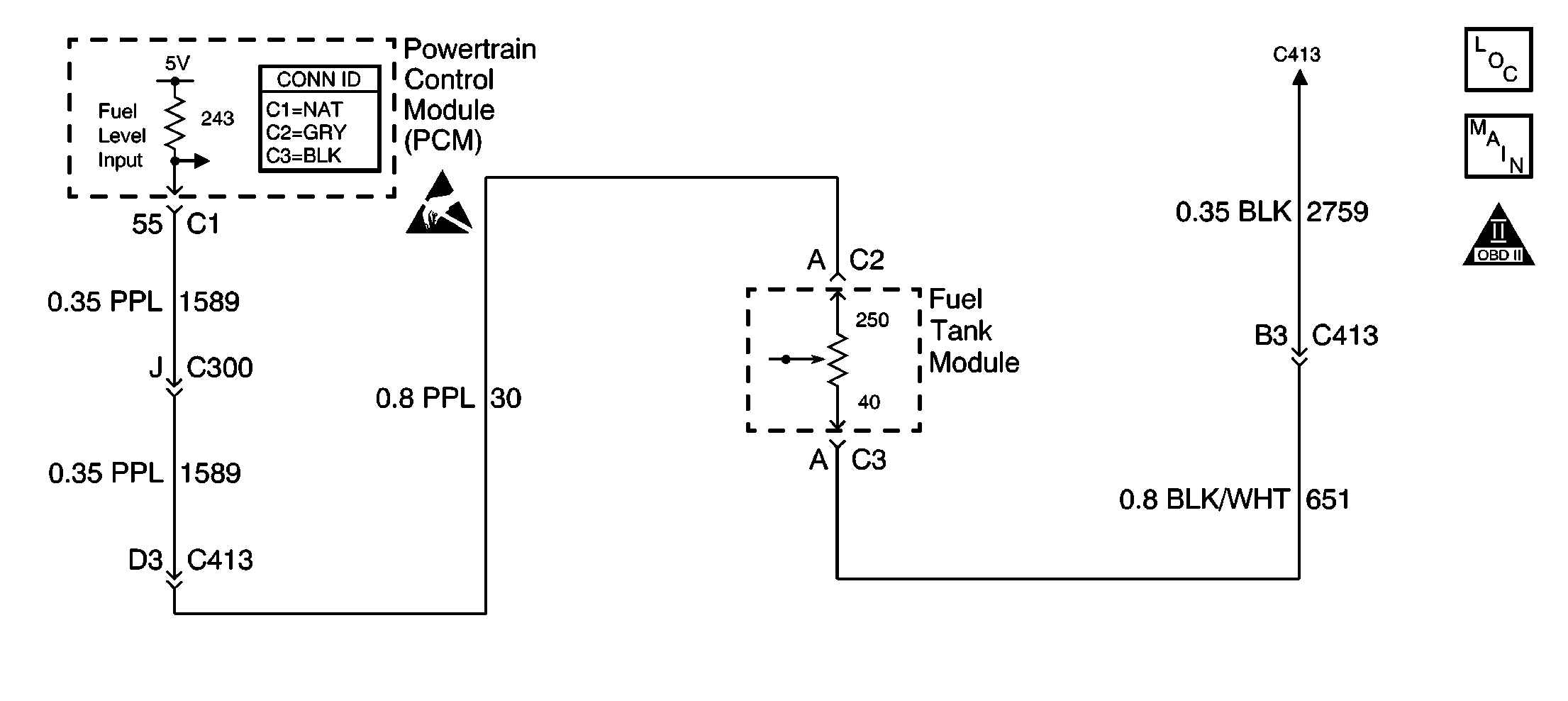
Circuit Description
The Powertrain Control Module (PCM) uses the fuel level input in order to calculate the expected vapor pressures within the fuel system. These vapor pressures vary as the fuel level changes. The vapor pressure is critical in determining if the evaporative emissions (EVAP) system is operating properly. The PCM also uses the fuel level in order to determine if the fuel level is too high or too low to be able to accurately detect EVAP system malfunction.
Conditions for Running the DTC
| • | The ignition is ON. |
| • | The system voltage is between 11 and 16 volts. |
Conditions for Setting the DTC
The fuel level sensor reading is more than 98 percent for 25 seconds or more.
Action Taken When the DTC Sets
| • | The PCM will record the operating conditions under which the diagnostic fails. This information is stored in the Failure Records buffer. |
| • | A history DTC is stored. |
Conditions for Clearing the DTC
| • | A history DTC clears after 40 consecutive warm up cycles without a fault. |
| • | Use a scan tool to clear the DTCs. |
Diagnostic Aids
| • | Inspect for the following conditions that may cause intermittents: |
| - | Poor electrical connections |
| - | Rubbed through wire insulation |
| - | A wire that is broken inside the wire insulation |
| • | Thoroughly inspect any circuitry that is suspected as causing the intermittent complaint. Inspect for the following conditions: |
| - | Backed out terminals |
| - | Improper mating |
| - | Broken locks |
| - | Improperly formed or damaged terminals |
| - | Poor terminal to wire connections |
| • | Before replacing the PCM, inspect the PCM electrical connector terminals for the following conditions: |
| - | Improper mating |
| - | Broken locks |
| - | Physical damage to the wiring harness |
Diagnostic Aids
| • | Inspect for the following conditions that may cause intermittents: |
| - | Poor electrical connections |
| - | Rubbed through wire insulation |
| - | A wire that is broken inside the wire insulation |
| • | Thoroughly inspect any circuitry that is suspected as causing the intermittent complaint. Inspect for the following conditions: |
| - | Backed out terminals |
| - | Improper mating |
| - | Broken locks |
| - | Improperly formed or damaged terminals |
| - | Poor terminal to wire connections |
| • | Before replacing the PCM, inspect the PCM electrical connector terminals for the following conditions: |
| - | Improper mating |
| - | Broken locks |
| - | Physical damage to the wiring harness |
Test Description
The numbers below refer to the step numbers on the diagnostic table.
-
This step simulates a DTC P0462. If the PCM senses the change, then the PCM and the fuel level sensor wiring are OK.
-
The replacement PCM must be programmed and the Crankshaft Position System Variation Learn procedure must be performed.
Step | Action | Value(s) | Yes | No |
|---|---|---|---|---|
1 | Did you perform the Powertrain On-Board Diagnostic (OBD) System Check? | -- | Go to Step 2 | |
2 |
Is the fuel level sensor value more than the specified value? | 3.5% | Go to Diagnostic Aids | Go to Step 3 |
Disconnect the fuel level sensor connector. Is the Fuel Level sensor value more than the specified value? | 98% | Go to Step 5 | Go to Step 4 | |
4 |
Did you find and correct the condition? | -- | Go to Step 7 | Go to Step 6 |
5 |
Did you complete the repair? | -- | Go to Step 7 | -- |
|
Important:: The replacement PCM must be programmed. Refer to Powertrain Control Module Replacement/Programming . Replace the PCM. Refer to Powertrain Control Module Replacement . Did you complete the repair? | -- | Go to Step 7 | -- | |
7 |
Does the DTC reset? | -- | Go to Step 2 | System OK |
